Student Clubs Offer Opportunities to Learn and Lead
Our VetCats have organized a vibrant array of clubs to explore their interests and develop their networks.
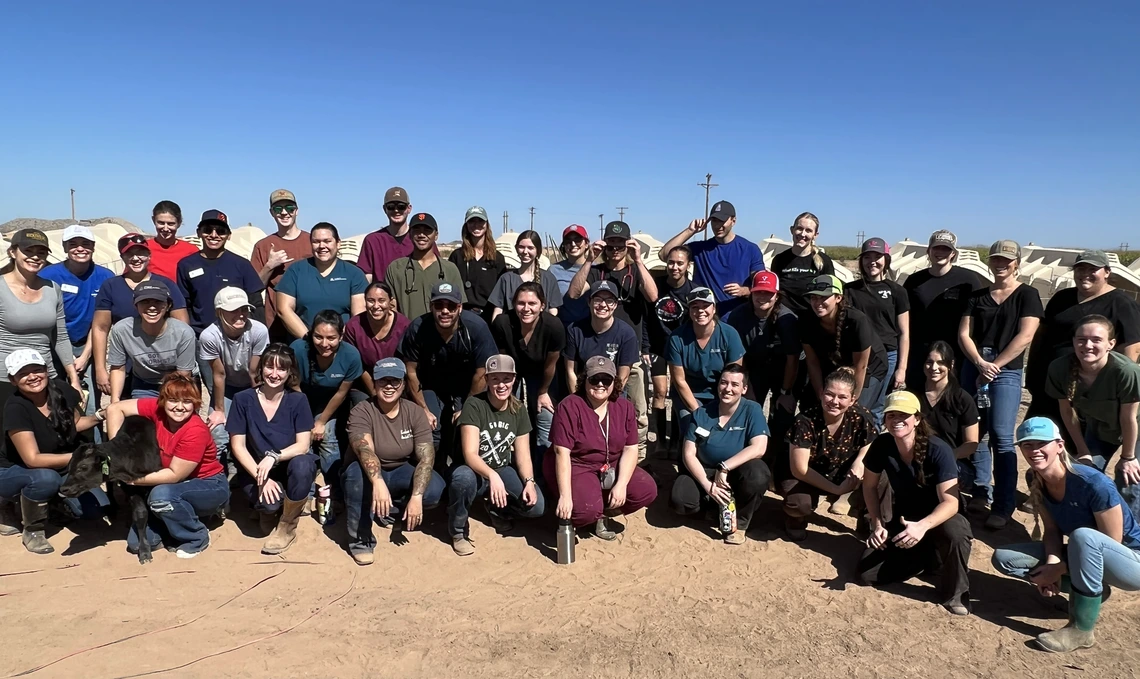
Our VetCats have organized a vibrant array of clubs to explore their interests and develop their networks. Club leaders have shared some exciting insights into their organizations.
Street Medicine Club
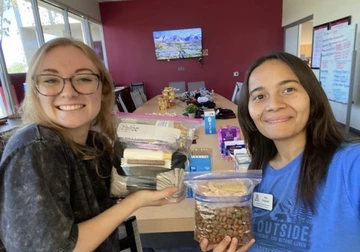
We had the opportunity to speak with the Street Medicine Club President Alia Tobolski to learn more about the club and their mission to support the community.
Could you tell us about the Street Medicine Club’s mission and vision?
Street Medicine Club is a student group that aims to advocate for the homeless/un-housed, low-income, and underserved communities and their pets by fundraising for supplies, providing healthcare under the supervision of a veterinarian, and learning from veterinary professionals about the field.
Why was it important to you to start this club on our campus?
I grew up in a single-parent, low-income household. My mother taught my brother and me how to stretch our resources and help others in our community. I started this club to support low-income families and individuals experiencing housing insecurity because I understand how poverty can affect other areas of your life. I also understand how a loving pet can tremendously impact our emotional, mental, and physical health; I’d like to do my part to support that relationship.
What opportunities does your club provide?
In 2022, about 12.5% of Arizona’s population lived below the poverty line. Our club supports the community by organizing donation boxes for homeless shelters and local food banks. We also create and allocate homeless car kits to people struggling with housing insecurity. If individuals are interested in the club, members will help to create homeless care kits, present veterinary care lessons for UA RISE Health and Wellness Center, and help with upcoming fundraisers.
How does your club help support the well-being of our community?
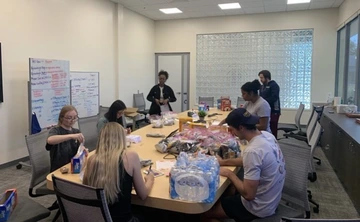
Poverty has a far-reaching impact. Therefore, the Shelter Medicine Club has a diverse portfolio. In October, we created over 60 homeless care kits for those in need. The kits included hats, socks, non-expiration food, bandaids, dog food/treats, water, etc. We have another homeless care kit event planned for next semester. We are also organizing a partnership with UA RISE Health and Wellness Center. UA RISE Health and Wellness Center is an organization that provides classes to low-income individuals, as well as those struggling with substance abuse and mental illness. Our club was asked to present a lesson about veterinary care and provide a forum for questions related to animal care. We have a partnership with the Sister Jose Women’s Center. Sister Jose Women’s Center is one of the few homeless shelters in Tucson that house animals. In addition, we partnered with Feeding Pets of the Homeless to collect food/supplies for those in need during the holiday season.
What has been your favorite part of being in leadership?
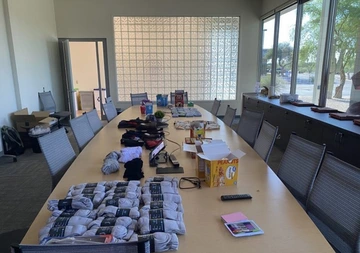
This leadership role allows me to serve a population group that’s familiar and in desperate need of resources and care. I enjoy learning about the different organizations that support and advocate for people struggling with housing insecurity and low-income families: Sister Jose Women’s Center, Feeding Pets of the Homeless, UA RISE Health and Wellness Center, and Street Dog Coalition. They’re invaluable to our community and provide a blueprint for compassionate change. They’re my heroes.
Any additional thoughts or information you’d like to share?
As a new club, our goal is to establish partnerships to help create a strong foundation for the next cohort. Our club couldn’t function and thrive without help. I want to thank Hannah and MacKenzie for their hard work as we navigate this process. I would also like to thank our members for participating and supporting our mission. I want to thank our club advisor, Dr. Wesley, for her support and guidance. I want to thank Ms. Perez for her help throughout this process and for enthusiastically answering all of the emails. I would also like to thank my mother and brother for being my biggest supporters. A huge thank you to everyone who donated supplies to our donation box or participated in our homeless care kit event. I want to express our thanks to the community organizations that gave us a chance to learn, support, and serve. Lastly, I’d like to thank the resilient members of our community. You are seen.
Food Animal Club
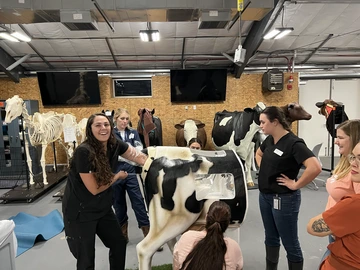
We had the opportunity to speak with the Food Animal Club President Ross May to learn more about the club and their mission to support students throughout their ongoing veterinary journeys.
Could you tell us about the Food Animal Club’s mission and vision?
The mission of the Food Animal Club is to provide CVM students with extracurricular opportunities that will help make us day-one-ready livestock practitioners. Our fast-paced curriculum makes it impossible for our instructors to teach all the basics about livestock that students without a food animal background may need. Our club aims to allow students to experience many aspects of the livestock industry and, hopefully, see where they fit into food animal medicine. We encompass three professional organizations, including AABP (cattle), AASRP (small ruminants), and AASV (swine). My personal goal for the club is to provide a wide variety of experiences that will supplement our curriculum and expose my peers to a wide variety of food animal experiences that we may not get in the classroom.
Are most of the students in your club interested in pursuing a career focused on food animal medicine?
While we do have some members committed to food animal medicine, most of our members are students who either want to be mixed animal practitioners or don’t yet have a lot of experience with livestock animals. One of the most rewarding parts of leading this club has been watching first-year students who do not have livestock experience come to our events and enjoy themselves. My hope is that we can help spark an interest in food animal medicine in students who may have never imagined themselves participating in this aspect of veterinary medicine.
Why do you believe it is essential for students to have more exposure to food animal medicine?
I believe that it is essential for students to have more exposure to food animal medicine because many of my classmates are coming into veterinary school with no experience in this area. Without exposure to livestock, they may never learn that they enjoy food animal medicine. One goal of our school is to produce rural veterinarians for Arizona. Our club plays an important role in exposing students to a key aspect of rural practice: food animal medicine. Even if our club members do not go into food animal medicine, I think it is valuable to understand how our food is produced. Learning about the safety measures and regulations that go into food animal medicine to ensure a safe food supply, as well as the animal welfare procedures we implement, gives club members an appreciation and understanding of the animal agriculture industry they may not otherwise have. Even veterinarians who are not practicing food animal medicine may be asked questions by their clients regarding the way our food animals are cared for and having an understanding of the producer’s perspective will better inform their answers.
What opportunities do you provide for your members and other interested students?
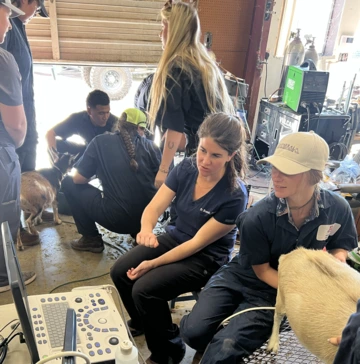
We provide a wide variety of opportunities for our members. We host ‘Lunch and Learns,’ where veterinarians and industry representatives present educational information to our members and other interested students. These are great learning opportunities; however, our real pride and joy are the hands-on labs we provide our members. This semester alone, we hosted a necropsy lab, an ultrasound lab, a calf processing lab, an artificial insemination lab, and several piglet processing labs. We have even more exciting plans in the works for next semester. These activities often entail a ‘dry lab’ where students learn techniques and practice on models, followed by a ‘wet lab’ during which we practice non-invasive procedures on live animals. These opportunities would be impossible to provide without the help of our faculty veterinarians, including Dr. Martin and Dr. Brownlee, and community members who allow us to learn with their animals. We owe them all a huge debt of gratitude. We also try to give back to the community by donating our time when possible. Our members have helped with activities such as 4-H livestock judging clinics and FFA Veterinary Science contests and we are currently planning a parasitology lab for 4-H students next semester.
What do you love most about this part of veterinary medicine?
What I love most about this part of veterinary medicine is that we are helping people by helping animals. We get the unique opportunity to help producers solve complex problems, and in this line of work, every day presents a new challenge. Another aspect of veterinary medicine that I think is often overlooked is our role in maintaining a safe food supply. As food animal practitioners, the patients we care for usually will end up in the food supply at some point and may produce products such as milk or eggs. Whether consumers realize it or not, they are inherently trusting veterinarians to keep these animals healthy and, as a result, keep the food they purchase safely. Maintaining this social contract is a responsibility unique to food animal medicine that I find rewarding. At the end of the day, we know that our work is serving the animals, the producers, and consumers all over the world.
If you could address one misconception about food animal medicine, what would it be?
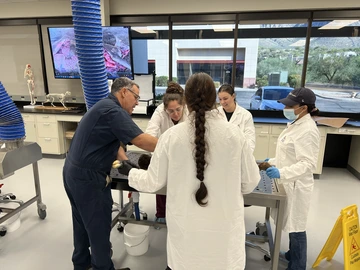
I think one of the biggest misconceptions about food animal medicine is that we look at these animals only as commodities, not as individual animals that deserve a high standard of care. In my experience, this is not true. It is true that we are often working with large herds and practicing population medicine to do what is best for the majority. However, as veterinarians, we continuously work to improve our patients’ welfare. We would not be in veterinary school if we did not have the desire to improve animal welfare on an individual and population level. I think some people have a hard time accepting that the ultimate fate of these animals is to enter the food supply and that while they are under our care, we are working meticulously to maximize their welfare. In my experience, both can be true. After all, an unhealthy or unhappy animal does not produce meat, milk, eggs or fiber nearly as well as a properly cared-for animal.
Any additional thoughts or information you’d like to share?
I appreciate this opportunity to share information about the Food Animal Club. We are one of the biggest and most active clubs on campus. I encourage any students interested in food animal medicine or curious about the industry to reach out and join us. We welcome any experience level and members can choose which events they attend based on their interests. If anyone has further questions or ideas for our club, I look forward to hearing from them.
Student National Association of Black Veterinarians
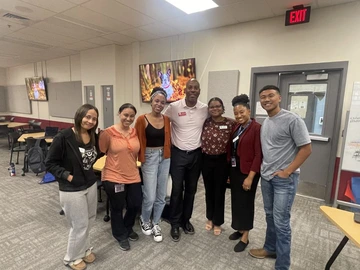
We had the opportunity to speak with SNABV President Danasia Perry to learn more about the SNABV club and their mission to support students throughout their ongoing veterinary journeys.
Could you tell us about the SNABV’s mission and vision?
The Student National Association of Black Veterinarians is one of many student chapters that represent the National Association of Black Veterinarians (NABV). The NABV’s goal is to help increase the number of Black people in veterinary medicine and increase awareness of the veterinary profession amongst K-12 and undergraduate students through outreach, removing the barriers that prevent Black students from entering the profession and creating a pipeline into veterinary medicine.
As a student chapter, the main ways we want to support our Black Students is through professional development and a supportive community. Veterinary medicine as a whole is less than 2% African American, so we want to have multiple African American veterinary professionals provide talks on their experiences and careers in veterinary medicine to show our students the endless possibilities available to them. We also recognize that veterinary medicine can feel lonely and isolated as a Black student, so we offer mentorship, social activities, and study halls to continue to build each other up through our veterinary careers.
Why was it important to you to start this club on our campus?
As I mentioned previously, veterinary medicine is less than 2% black so this club helps current students feel like they have a place where they belong. It can be hard being in a class with 110 people and only seeing 2-3 people who look like you or feel like your teammates don’t understand your background, so this club just helps us find our community. In addition, our club can help prospective African American students know that there is going to be people here who are ready and excited to welcome them and support them as they start their vet school journey here at our UA CVM!
What opportunities does your club provide students on our campus?
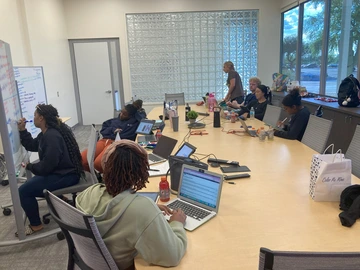
Our club provides tutoring opportunities! Our second-year students have been kind enough to tutor our first-year students who are in the club, helping them prepare for midterms and finals, and we hope to provide regular study halls as we move into the spring semester! In addition, we offer unique opportunities to network with black veterinarians. For example, Dr. Antonio Bowens, our neurology teacher, has connected some of our members with a large animal internal medicine specialist, a female veterinarian who also has a law degree, and so much more! There’s also opportunities to go to the NABV conference in June, which is where we can network with other black veterinarians across the country and hear about ways African Americans are paving the way in veterinary medicine.
In your opinion, why is representation so essential in veterinary medicine?
Representation is so important because of two reasons. First, seeing other African American young adults pursue a career in veterinary medicine can be so inspiring for undergraduate and high school students who may have never even considered pursuing this career. When you don’t see people who look like you in the field, it makes you feel that there isn’t a seat available for you at the table and you wouldn’t be welcomed if you tried to bring your own seat. Representation helps them know that there’s not only a seat available, but we have too many seats open and we want and need you here in this profession!
Second, it is so impactful to our clients to see a veterinarian who looks like them, who understands their background, and who can connect with them on a different level. Dr. Arianna Adams, a class of 2023 graduate, has already had people show surprise and be grateful to see her in the exam room because it helps our clients feel more comfortable and supported!
What is your favorite part of being in leadership?
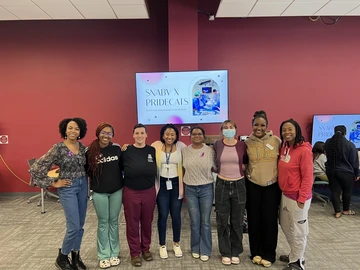
My favorite part about being in leadership is just being able to be create the environment that I wish I had when I was starting to pursue veterinary medicine and begin my academic career here at the UA CVM. I get to create a community, tailor our events to the needs/wants of our members, and I just enjoy being someone that my classmates, the first-year students, and even prospective students can rely on and reach out to for anything. I’ve already had some prospective students ask me not necessarily about the club itself, but just tips and tricks on what to expect when they attend our school, and I love being that person for them!
Any additional thoughts or information you’d like to share?
I want all of the students at the CVM to know that while this club is focused on the advancement of African American students, it is open to everyone and our events can benefit every student on campus! We’ve had discussions about transitioning from vet students to veterinarian, how to succeed in vet schools, and how to build generational wealth as a vet student. In the spring semester, we hope to have a series exploring non-traditional careers in veterinary medicine and so much, so please consider joining!
